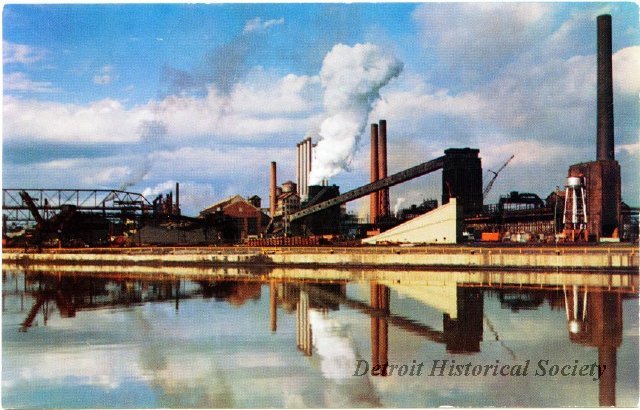Encyclopedia Of Detroit
Ford Rouge Complex
Henry Ford’s vision of a perfect industrial complex was realized with the construction of the Rouge Assembly Plant, or the Ford Rouge Complex, on 2,000 acres in Dearborn, Michigan. Ford hired noted architect Albert Kahn to design the Rouge’s buildings, with construction beginning in 1918. Kahn’s Glass Plant at the Rouge, now gone, is one of his most heralded industrial architectural designs. By the time the complex was completed in 1928, it contained 93 buildings and utilized its own railway system with more than 90 miles of track to distribute parts to buildings on its campus.
Ford’s plan for a self-contained production system, to create vehicles beginning with the raw materials to the final product that rolled off the assembly line, required that a portion of the Rouge River be dredged and widened to allow ore freighters to enter. The plant was one of the few to have its own foundry and coke ovens. With the goal of eliminating waste, residue from the blast furnaces went into a cement factory and a paper mill built nearby made cardboard boxes from scrap wood.
Henry Ford’s obsession with efficiency spilled over into other areas of the plant’s operation, including its cleanliness. At the peak of its employment, the plant employed more than 5,000 workers just to keep the grounds and buildings clean, painted and well-maintained. Between 1919 and 1926 the total number of employees was 75,000.
In 1937 the property was the site of the infamous Battle of the Overpass when Walter Reuther and other union organizers were met and beaten by Henry Ford’s strongman Harry Bennett and his men.
Over time the Ford Company started to relinquish some of the businesses and operations that sustained the all-inclusive operation, such as the ore mines and timberland in Michigan’s Upper Peninsula, and the steel-making, giving up River Rouge frontage and other land in the process. As of 2018, the plant sits on 600 acres with about 6,000 employees.
During its lifetime, the Rouge complex has turned out many of Ford’s most signature products, most notably the Ford Mustang and the iconic 1954 two-seater Thunderbird. During World War I, the plant churned out Eagle Boats for the U.S. Navy, an inaugural project for the plant in 1918. The Rouge plant made parts for Ford’s Model T, but the cars were assembled at the Highland Park plant.
The Ford Rouge is immortalized in Diego Rivera’s “Detroit Industry” mural at the Detroit Institute of Arts (DIA). In 1931 Rivera visited the Rouge for a month to study its machines and workers in order to represent them on the walls of the DIA, a project paid for by Edsel Ford.
In 1997, the Ford Motor Company embarked on a $2 million project to transform and modernize the Rouge complex. Shortly after its groundbreaking, an explosion at the Rouge power plant killed six workers and injuring 14 others in a disaster remembered as one of the worst industrial accidents in Michigan history. A memorial was erected at the complex for the deceased in 2004. Now called the Ford Rouge Center, the plant features lean, sustainable and flexible manufacturing processes and boasts one of the world’s largest living roofs. The Henry Ford offers daily tours of the Center to the public through its Rouge Factory tours.



